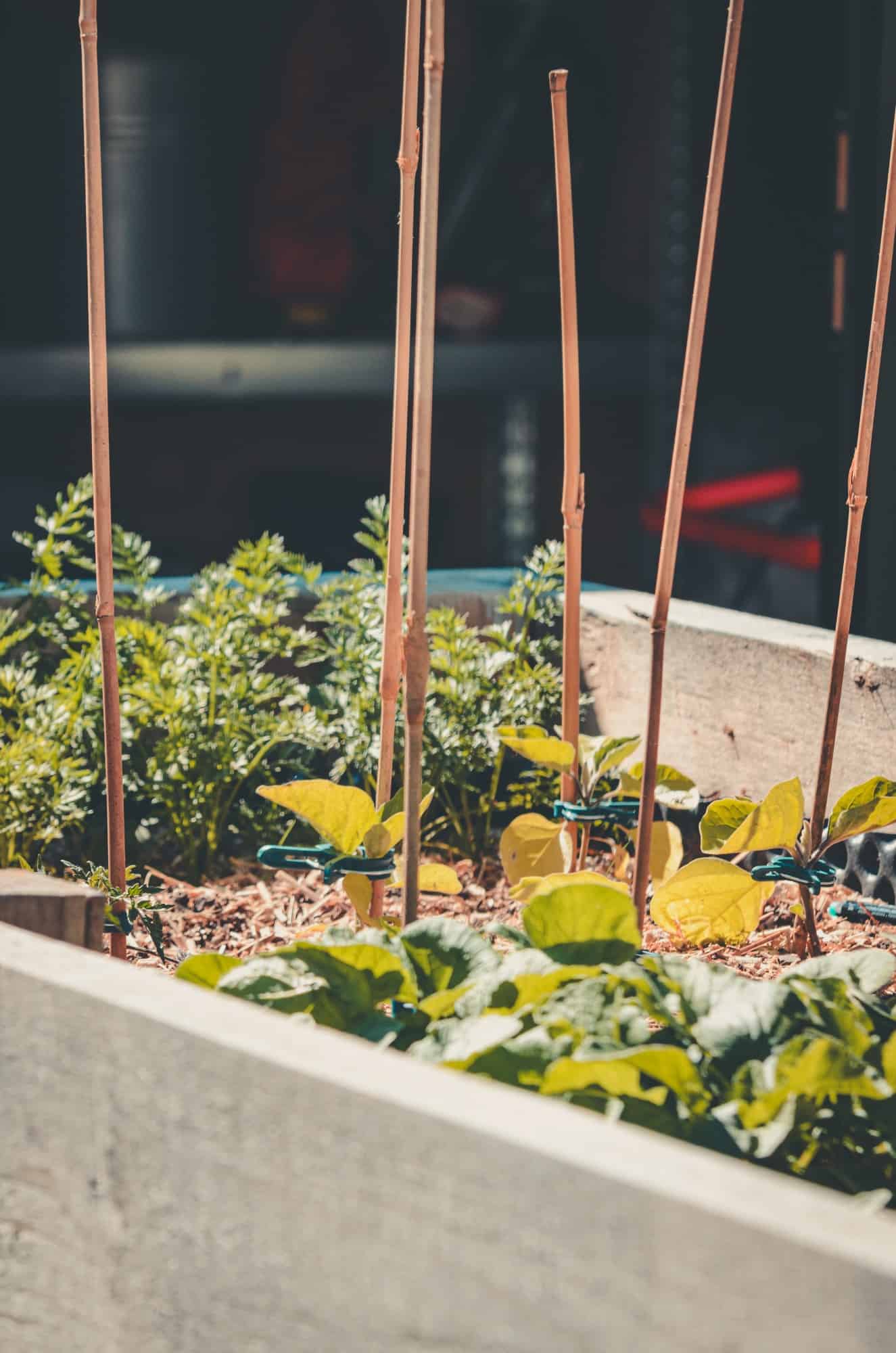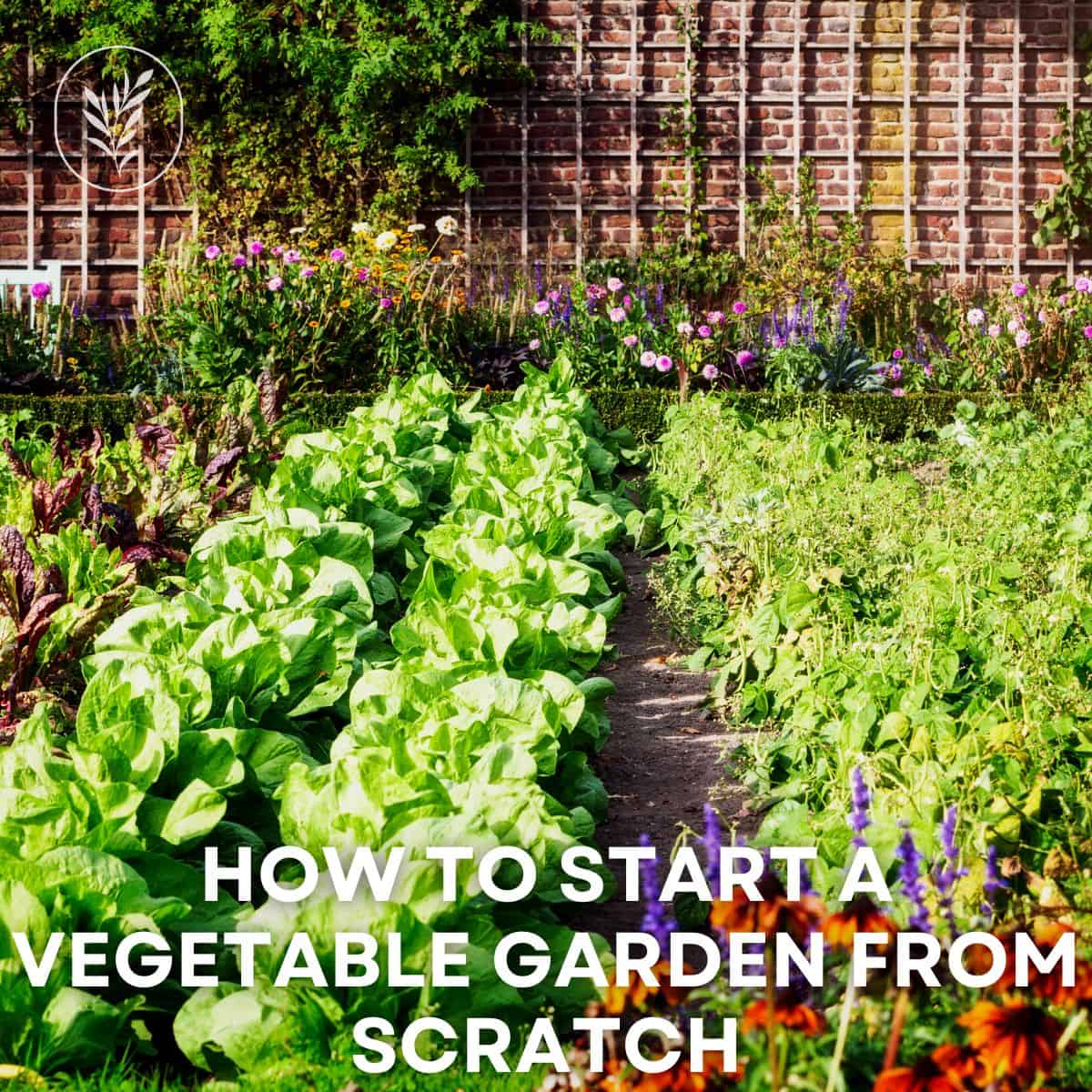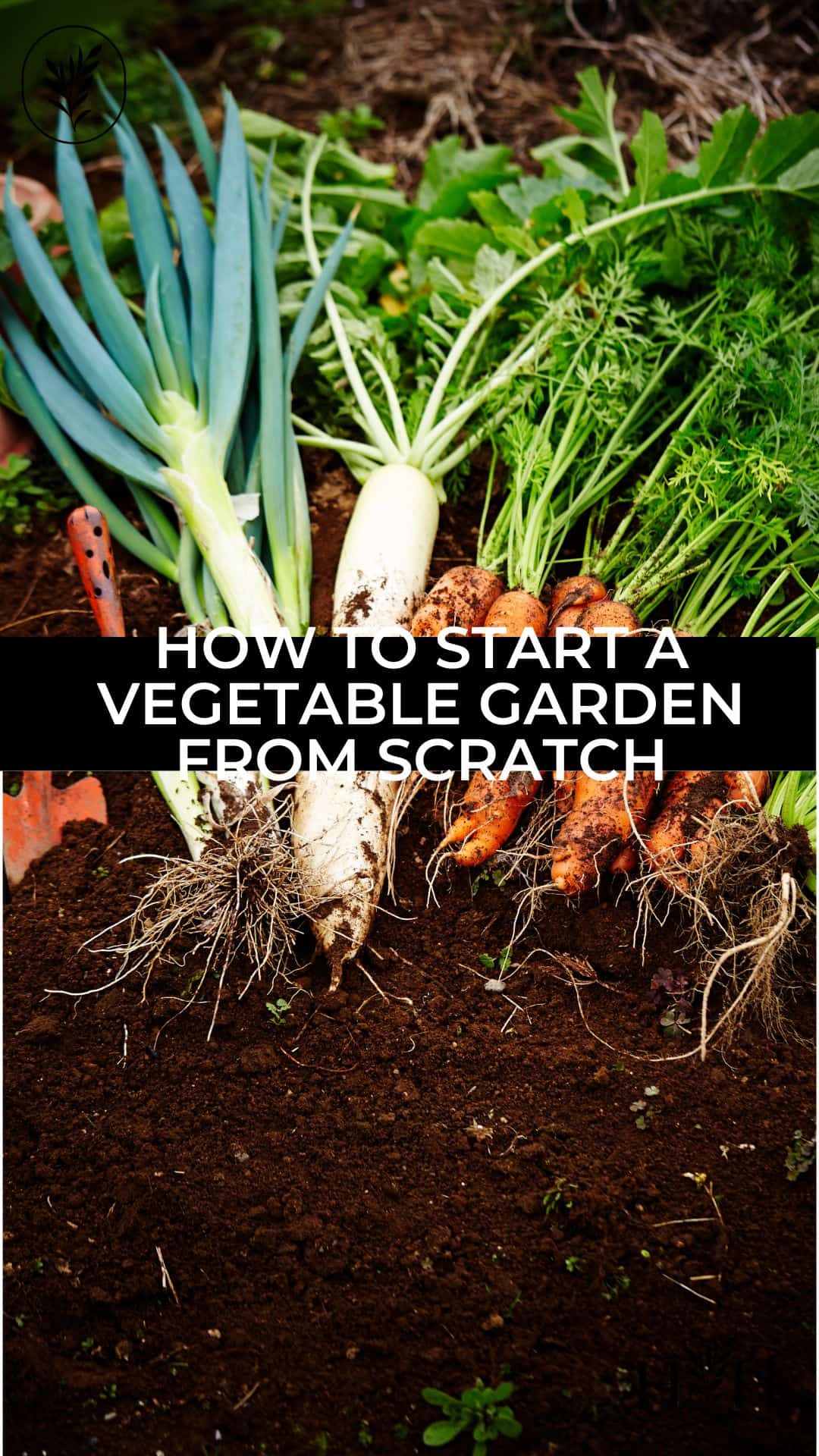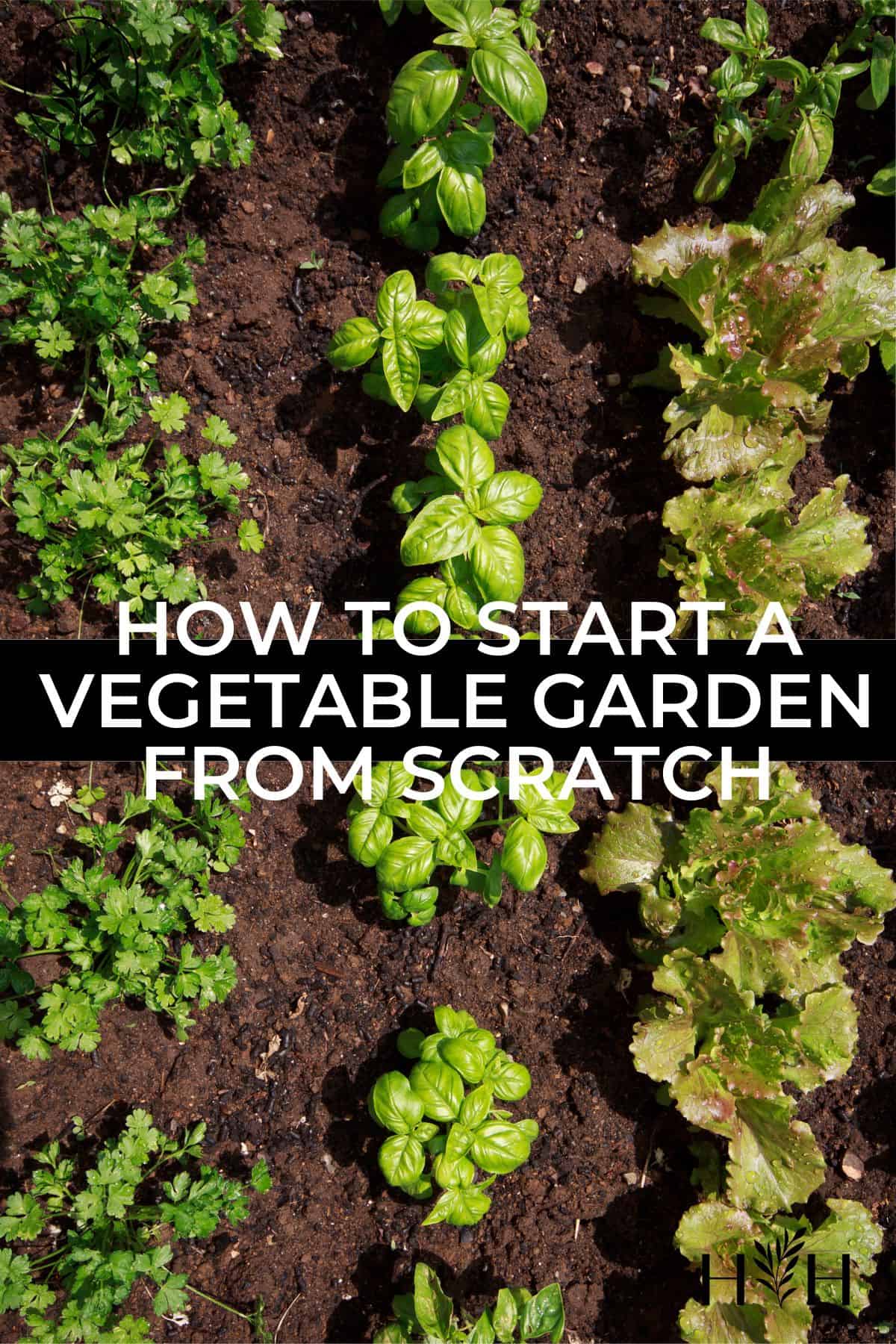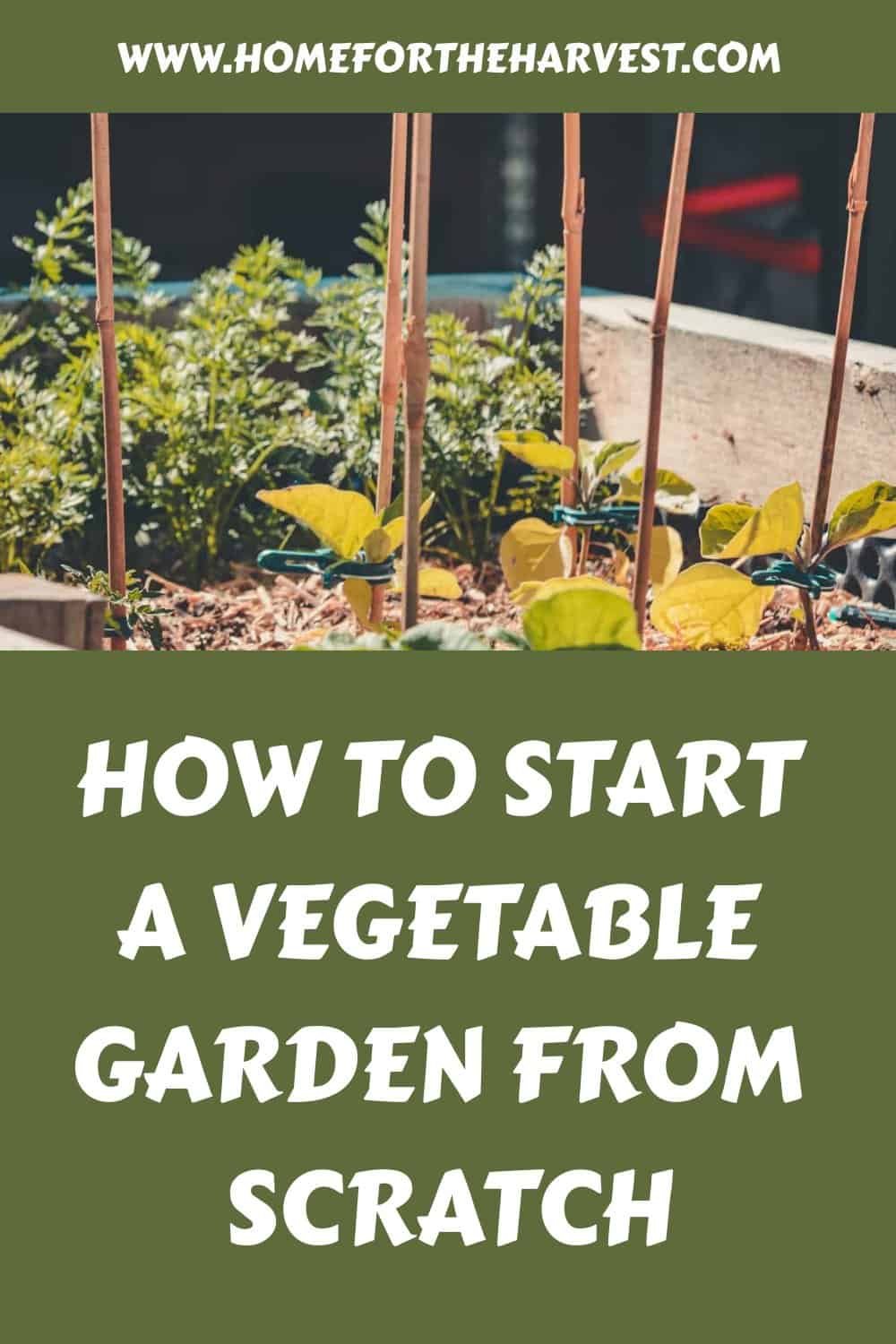Do you dream of starting to grow your own produce from the comforts of your home? Here are some tips to help you learn how to start a vegetable garden from scratch.
1. Plan your garden before you start digging
One of the most common beginner’s mistakes is to plant whatever and hope for the best. And at best, you’ll end up with a disordered, inefficient layout. At worst, you’ll be planting in such a way that your plants are working against each other. Garden planning is SO important when starting a vegetable garden from scratch!
So before you do anything else, you’ll want to have some idea of what you want out of your garden. The first thing that you will want to keep in mind is what crops you can realistically grow in your region and at what time of year. Figuring out what gardening zone you live in will give you an idea of what options are open to you.
For instance, if you live in a northern region, any crop that takes 100 days or more to mature is a gamble. Conversely, southern gardeners may have issues with crops like peas or cucumbers due to their higher vulnerability to heat and humidity. Though between the two, northern gardeners have more options as it’s easier to winterize a garden bed than shield plants from extreme heat.
The second thing to consider is what crops you and your family will actually use. For example, you might like the idea of growing pumpkins for the Fall. But unless you eat a lot of pumpkin pie or use lots of decorative pumpkins on your porch they may not be the most efficient use of your space.
2. Select your growing location in accordance with your planned crops
Another key reason why you want to start planning your garden in advance is that that will help you to select the right spots for the right crops.
If you’re looking at growing fruits and vegetables in your new garden, then most of the time, that means you’re looking for a spot with full sun. Full sun means that they’ll get a good five hours of sunshine a day. Green leafy vegetables and some herbs tend to grow best in partial shade.
A caveat to that rule is for southern gardeners. Since the sun gets more intense the further south you go, certain fruits and vegetables may benefit from being planted in partial shade. So remember to keep your gardening zone guide handy, and if possible, connect with other gardeners in your region for tips on what strategies work best in your area.
You’ll also want to consider ease of access when picking out a spot to do your planting. Naturally, you’ll need to be able to water, weed, and otherwise care for your garden. And the harder your crops are to reach; the more likely they are to find themselves neglected.
And depending on your area, you may also need to be careful about planting in frost pockets. These are low-lying areas with poor drainage. Because moisture tends to accumulate in them, they’re the first place where frost will settle during a cold snap.
3. Organize your new garden beds
Having decided what you plan to plant, the next step is to map out your planting beds. Specifically, You need to decide what type of bed you’re building and what size.
Size mostly depends on the space that you have available and what crops you’ll be raising. If you only have a modest space to work with, you may need to get creative. Fortunately, many crops like strawberries allow a certain amount of flexibility in where and how you grow them. As for what type of bed you build, that depends mostly on your available area.
Raised planting beds are attractive for a number of reasons. They’re aesthetically appealing, easier to access, and easier to set up than sunken beds. They’re also less disruptive to the roughly 70% of bee species that live underground. Raised beds are perhaps the best way to start a vegetable garden from scratch.
The trade-off is that they tend to dry out quickly, which may be a perk if you live in very damp areas. But if you live in a dry area, sunken beds may be the way to go due to their ability to retain moisture.
Whichever way you go, you’ll want to plan your beds in blocks rather than single rows of plants. Try to build them about 3-4 feet across to ensure that you can easily reach them from either side. Within these spaces, plant your crops in a grid format, keeping in mind the amount of space that a given crop needs to grow. Here are some vegetables that grow best in raised beds.
4. Group plants that grow well together and complement each other
You want to group plants not only so that they’ll have enough space to grow, but also so that they will work in harmony with one another.
The simplest consideration here is that you want plants whose sizes will work in synergy. For instance, you don’t want to grow a tall crop next to a much lower-lying one if both need full sun, as the taller one will end up starving the smaller one. What you could do, however, is use a tall crop like corn or sunflowers to provide shade for greens or herbs if your garden doesn’t have much shade to go around.
You’ll also want to take water requirements into account. If you place two crops with too disparate needs together, you’ll either have to drown one or parch the other. Make an effort to research how much water each crop needs whenever starting a vegetable garden from scratch. You’ll learn more and more each season and refine your layout and future plans.
Another consideration is what kind of cover crops you’ll use when areas of the garden aren’t in use. Cover crops, as the name implies, are planted for the purpose of covering bare soil, rather than for harvest. They prevent soil erosion, lock in moisture, and help build fertility in the soil. Cover crops are sometimes called “green manure”, as they enrich the soil.
Popular green manure plant choices include buckwheat, clover, and alfalfa. Buckwheat, in particular, is a good choice since the flowers it produces can attract pollinators and other beneficial insects to help keep pests in check without the use of pesticides.
5. Test your soil whenever starting a vegetable garden from scratch
So with your ideas in hand, the next thing that you’ll need to do is test your soil. Doing a proper garden soil test is key to success when learning how to start a vegetable garden from scratch.
Things you’ll want to know are your soil’s pH levels, the distribution of sand, rock, clay, and silt, the availability of basic nutrients, and especially if there are any toxic contaminants in the earth.
Some of these items, like the presence of rocks and sand and such, you can tell just by looking. But if you need to know if say, your soil contains lead from old house paint or runoff from a nearby road, that can require a professional lab test.
Testing pH levels is simpler, as there are home test kits available. Most plants prefer a pH of around 7 — true neutral. But there are some that skew more acidic or more alkaline, so remember to check the individual requirements of all of your crops.
6. Build your garden soil from scratch
Now we can get to the work of building your garden. And like building a house, we start with the foundation. Most plants like a deep, well-drained patch of earth that’s rich in organic matter. How you accomplish that depends on your circumstances.
If you’re starting with sod or weeds, you’ll need to deal with that. The most straightforward way would be to just chop it up or till it down into the soil.
But an even easier way to start a vegetable garden from scratch would be to cover it with wet cardboard or newspaper and smother it. The cardboard and paper will break down into the soil, and in the meantime, you just build your planting bed on top of it.
Whatever the case, you’ll need to feed the soil so that it can feed your crops in turn. If you’re just starting out, the simplest way to do this is to buy pre-prepared compost from your local garden center. Even better, though, is to make your own.
It takes time, but it gives you the ability to determine the exact makeup of your soil amendments, great for if you’re trying to grow crops that need specific nutrients or a particular pH to thrive.
This is the point where you’ll need to place the edges of your garden beds. If you have the time and means, there are some interesting options to pick from.
7. Pick out the right seeds and transplants for your garden
Depending on the crops you’ve chosen, your plants may do better either grown from seeds or grown from transplants. And for specific varieties like heirloom seeds, you’ll almost always need to grow your own transplants instead of planting them directly into the earth.
For beginners starting a vegetable garden from scratch, the easiest way to get started is to buy transplants (baby seedling plants) from a nursery. If you decided to go this route, here are a few things to keep an eye out for:
- Look for plants that are roughly the same size as their pots. A large plant growing in an undersized vessel is probably rootbound and may suffer from shock and die when transplanted.
- Look for common signs of stress. Wilting, yellow leaves and insect damage should all be red flags. During the spring and summer months, many plants at nurseries are susceptible to heat damage, in particular, so keep an eye out for that as well.
- Ensure that the plants haven’t been sprayed with pesticides or other harmful chemicals. Encouraging pollinators to visit your garden will be vital to get your crops to fruit, so anything that could discourage or harm them needs to be avoided.
If you can’t find the right transplants for your garden, starting your own seedlings is always an option. Particularly so if you have an indoor area where you can protect them from pests and the elements.
8. Plant the seeds & seedlings in your garden carefully
Seed packets and store-bought transplants will usually come with instructions on how to plant them. In the off-chance that they didn’t, or if you grew your own transplants, here are some rules of thumb to keep in mind.
- Unless otherwise noted, most seeds should be planted at a depth around three times their diameter. While most need to be covered in earth, there are a few that need direct sunlight to germinate.
- Most transplants should be planted at the same depth at which they were growing in their original pots. Except for tomatoes!
- Wait until after the last expected frost to plant, especially for warmth-loving plants like peppers and tomatoes.
And in general, remember that young plants are much easier to damage than older ones. Be gentle during the planting or transplanting process.
9. Give your garden the attention it needs
Your garden will require consistent upkeep to stay healthy and grow. Both watering and feeding your garden will be regular responsibilities, but they will pay off in making pest management that much easier. Harmful pathogens are most attracted to plants that are already weak or stressed. If you can keep your crops healthy, to begin with, your pest problems should be negligible.


